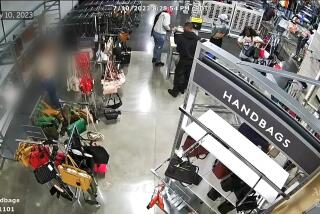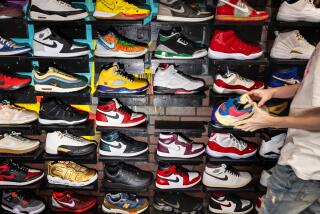The New Foreign Aid
This Appalachian town declared itself the Sock Capital of the World for good reason.
It began making stockings in 1907 and once boasted of producing 1 of every 8 pairs worn on the planet. The cushion-sole sock was invented here. Local sock makers are models of U.S. manufacturing, working hard, sharing resources, shaving expenses, investing in technology.
The Robin-Lynn Mills Inc. factory, for instance, owns some of the finest equipment in the business, electronic knitting machines from Italy that set the company back more than $25,000 apiece and can spin out a sock in 75 seconds, with the toe seam automatically sewn.
But Robin-Lynn, whose employees typically earn about $10 an hour, didn’t turn a profit last year. On the other hand, Three Star Socks in Datang, China, made about $500,000 using knitting machines worth $1,000 each and paying its workers an average of 60 cents to 70 cents an hour plus room and board.
But this familiar story of an enormous difference in costs is only part of the tale of two sock makers and their two towns.
China’s advantages in the global marketplace are moving well beyond cheap equipment, material and labor. The country also exploits something called clustering in a way that the United States just can’t match.
Drawing on its vast population and mix of free-market and central-command economic policies, China has created giant industrial districts in distinctive entrepreneurial enclaves such as Datang. Each was built to specialize in making just one thing, including some of the most pedestrian of goods: cigarette lighters, badges, neckties, fasteners.
Industrial clusters are like one-stop production centers, achieving economies of scale and driving innovation by geographically bunching suppliers, manufacturers and contractors.
The clusters are one reason China’s shipments of socks to the U.S. have soared from 6 million pairs in 2000 to 670 million pairs last year. Meanwhile, American producers, pummeled by imports from China and elsewhere, saw their share of the U.S. hosiery market fall from 69% in 2000 to 44% in 2003, according to the latest industry data.
Prodded by persistent lobbying from U.S. textile makers, the Bush administration late last year imposed limits on Chinese socks. The limits, which will remain in force until October, are intended to stave off surges in imports resulting from the expiration at the start of this year of global textile quotas that had allocated market shares in the U.S. clothing market to various foreign countries.
But the limits haven’t slowed the juggernaut. Chinese imports of socks have jumped in the first quarter, as have other apparel, triggering renewed calls in Washington for limits on more Chinese products.
“We’re just trying to pay the bills right now,” said Dale Jackson Jr., general manager of Robin-Lynn Mills, which has shed nearly a third of its workers in the last two years and has begun to send packaging work offshore. Even that may not be enough. Unless something dramatically changes, Jackson said, “there’s no possible way for us to compete.”
Sock making came to Fort Payne by necessity after the area’s iron and coal mining boom went bust in the early 1900s. Residents persuaded industrialists from Chattanooga, Tenn., 50 miles to the north, to open a hosiery mill in an abandoned hardware building.
Since then, socks have dominated the economic life of this town of about 13,000 people. Locals still recall how the community received a special commendation for supplying 8 million pairs of socks to the Army during World War II. By the 1990s, 1 of every 3 jobs in the Fort Payne area was related to socks.
Through 2000, as China was on the rise as an apparel manufacturer and most of the U.S. textile and clothing industry was in increasing trouble, Fort Payne hosiery makers largely flourished, aided by continued innovation and automation.
Now 39, Jackson was born and raised in Fort Payne, though his family had no connection to the hometown industry. His father sold newspaper-baling machines for a living, and the family struggled to make ends meet. But when Jackson returned to town to marry his high school sweetheart, Christy Kilgro, after graduating from the University of Alabama with a degree in psychology, he saw he could have a prosperous career with Robin-Lynn.
Jackson started there in 1988 making $4.15 an hour. He recalled the 1990s as filled with company-sponsored outings to amusement parks in Chattanooga and boat rides on the Tennessee River, regular pay increases, cookouts and deep-sea fishing trips for supervisors.
He moved into management in a few years and received hefty raises, building a comfortable house on five acres of woods in Lookout Mountain, a 10-minute sloping drive from the mill and the Terrapin Hills Country Club where he plays golf. He earns about $100,000 a year.
“There was an overall feeling of prosperity and the comfort of a good opportunity for anyone who chose to work in hosiery,” said Jackson, a high-strung man with bifocals and a Marine’s haircut.
In 1999, Robin-Lynn shipped 30 million pairs of socks and its sales topped $24 million. It would turn out to be the company’s best year. As U.S. retailers and their buyers searched for bargains, moving from higher-wage places such as South Korea and Taiwan to Pakistan and China, they squeezed profit margins tighter and tighter.
In 2004, Robin-Lynn manufactured about as many socks as in 1999 but generated just $12 million in sales.
About 6,000 miles away, Zhong Xiaolong, two years younger than Jackson, is the manager and owner of Three Star Socks in Datang, probably the only other town in the world where socks matter as much as they do in Fort Payne.
There are many similarities. Three Star, which produced about 20 million pairs of socks last year, has 160 employees and 170 knitting machines. Robin-Lynn has 170 employees and 150 machines. Neither company produces its own label. Both fill orders for larger hosiery manufacturers or intermediaries. Both make cushion socks that sell at stores such as Wal-Mart for $3.76 for five pairs. Of course, there are big differences too.
Most of Three Star’s machines, made in China, are so antiquated that they run on pulleys and require workers to constantly clean up lint formed during knitting. It takes Three Star three times as long as Robin-Lynn Mills to crank out the same sock — and without the toe seamed. That requires an extra step: a seamstress manually closes the toe.
But at the end of the day, Three Star produces and ships cushion socks at a cost of 27 cents a pair. Robin-Lynn’s cost: 41 cents. That gap explains why Three Star is nabbing more Wal-Mart orders while Robin-Lynn’s production for the retailer is shrinking.
“Of course I want to buy high-tech equipment and the best machines,” Zhong said. “But so far, it’s enough.”
Zhong’s cost advantage, of course, is largely generated by cheap labor. That is what people in the business in Fort Payne complain about. They also say China’s undervalued currency gives manufacturers there an unfair advantage in that they can sell their exports cheaply overseas.
But what gives Zhong and others like him a real edge — an edge even other low-wage countries like Pakistan can’t equal — are the benefits of clustering. Although manufacturing clusters aren’t new, with Italy especially known for them, the Chinese have taken it to a new scale.
In the Datang area, more than 10,000 households in 120 villages make their living off socks, according to researchers at Beijing University. Last year, Datang made 9 billion pairs of socks, while Fort Payne made less than 1 billion.
Datang’s myriad sock-related businesses include about 1,000 textile material processors, 400 yarn dealers, 300 sewing firms, 100 pressing operations, 300 packagers and 100 forwarders. Thousands of sewing shops, with an average of eight knitting machines each, produce socks for local, national and global markets.
If one of Jackson’s Italian-made knitting machines breaks down, he sometimes has to wait two months for delivery of parts. If one of Zhong’s machines goes on the fritz, he calls one of more than 60 merchants on Xingfang Street half a mile away that deal in used knitting equipment and parts. And if Zhong needs clips to bind a pair of socks together, he goes to Datang’s sock market, where a handful of stores specialize in metal clips, sold in bags of 10,000 for less than $2 a bag.
Specialization doesn’t necessarily mean more automation. Zhong takes his socks to be pressed at Jin Guo Socks Boarding Factory nearby, where inside a grimy brick house, dozens of workers who looked no more than 16 years old moved with lightning speed putting socks on thin metal plates, earning less than one-fourth of a penny for each pair.
When 600 pairs were set on plates, they were lined up on racks and pushed into a pressurized iron tank, where the socks were heated and steamed flat. In the back of the pressing plant, a lone man shoveled coal and wood into a furnace that fired the tank. The wood came from the mountains 25 miles away, said Li Minguang. “Every day,” he said, “we use a ton of wood and a ton of coal.”
The local government sponsors Datang’s annual international sock fair, which draws tens of thousands of buyers. What’s more, subsidies for electricity and natural gas support many mom-and-pop mills operating in sheds and living rooms. And hosiery businesses have received discounts of 50% or more on land purchases for new buildings, as well as tax abatements for creating jobs.
Still, it would be a mistake to think that clustering or government are the only reasons for Datang’s success. Many say Chinese factory workers are industrious. Private enterprise has a long tradition in this province, Zhejiang. Even during the Cultural Revolution of the 1960s and 1970s, when private economic activity was forbidden, people in the province traveled widely mending quilts, making popcorn and repairing shoes, according to a study of Datang by Beijing University researchers.
Unlike most other parts of China, “Zhejiang Province didn’t look down on the merchant class,” said Zhu Huasheng, an author of the study.
Three Star’s Zhong was 15 when he first tried his hand at his mother’s hand-grinding sock machine, working 10 hours straight to make 20 pairs, for which he earned $2.40 — four times the daily pay of a farmer at the time.
Now, he lives in a three-story house with Greek columns and a gold eagle at the top. Zhong built the house five years ago behind his 2-year-old factory and next to a gray, century-old concrete hovel where he was born and grew up without electricity.
Zhong drives a late-model Audi and his wife has a red Hyundai sports car. They keep a rare Tibetan dog as a pet. They send their two children to a private boarding school in the nearby city of Zhuji. Zhong completed only the ninth grade, but now he may be the richest man in his neighborhood and he makes no bones about what he wants out of life.
“Making money is my main priority,” he said.
In Fort Payne, clustering isn’t exactly unheard of. There are still scores of sock manufacturers, finishers, distributors and wholesalers in town. But it never had the kind of scale or depth of specialization as in Datang. Nor the kind of support from private investors or public sources.
Today, local government does what it can to support its most important industry.
“The city is subsidizing sewer rates a little,” said Mayor Bill Jordan, noting that wastewater costs for the hosiery industry haven’t gone up in years. “We’re limited in what we can do. Our hands are tied.”
Five years ago, sock businesses accounted for about half of Compass Bank’s loan portfolio in DeKalb County, which includes Fort Payne. Now it’s down to 10% and continues to fall. “When I go and sit across the president’s desk of a hosiery company, you’d like to see some confidence,” said Michael Metcalf, the bank’s president for DeKalb County. “But you just don’t see it like you used to.”
Several sock makers with deep roots in Fort Payne are confident, or at least aggressive.
“We’ve got to do whatever is necessary to maintain our competitiveness with our customers,” said Bobby Cole, president of 52-year-old V.I. Prewett & Son Inc., Fort Payne’s largest sock maker. Prewett produced 350 million pairs last year, mostly white socks for more than two dozen retail companies, including all the major discount stores.
Prewett, a privately owned company with annual sales of $170 million, two years ago installed six automated sock packaging systems that cost $125,000 each. Called Robosox, the Italian system presses, pairs, folds, stacks and packages socks. The equipment eliminated 40 boarding jobs, 10 pairing jobs and 24 sock-folding jobs. Prewett still employs about 1,300 people in town at its 15 mills, but that could shrink further. Just weeks ago, it placed orders for socks from Pakistan.
Charles Cole, Bobby’s older brother and the owner of Alabama Footwear Inc., is betting on technology. He spent $5.6 million on 200 new machines with automatic toe closers, paying $28,000 each.
Cole insists that the quality and comfort of socks produced by these machines outweigh those whose toes are sewn manually. Indeed, the Chinese agree that quality is slightly higher with automatic machines but say that, considering labor costs, China can hire far more inspectors to do what machines can’t. As for comfort, it’s unclear whether the typical consumer feels a difference — or cares.
At any rate, Cole figures it’ll take at least five years to recoup the investment on the new machines. “It’s a gamble,” he conceded.
At Robin-Lynn, 70 people lost their jobs two years ago, and everyone on the payroll, from the chairman on down, suffered a 10% pay cut. And Jackson started shopping for raw materials in Pakistan. The general manager used to buy yarn from mills in nearby North Carolina; even after adding in transportation expenses, the Pakistani yarn still cost 35% less.
Jackson hated cutting out his longtime Southern vendors. Many have gone under in recent years. But nothing, Jackson said, is sacred anymore.
“We’ll change vendors for anything. Yarn, supplies, light bulbs, it doesn’t matter,” he said. “The old loyalty where your buddy sold you the light bulb, that’s gone.”
More to Read
Inside the business of entertainment
The Wide Shot brings you news, analysis and insights on everything from streaming wars to production — and what it all means for the future.
You may occasionally receive promotional content from the Los Angeles Times.









